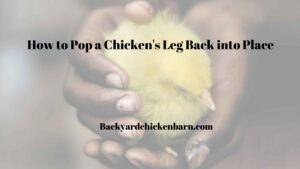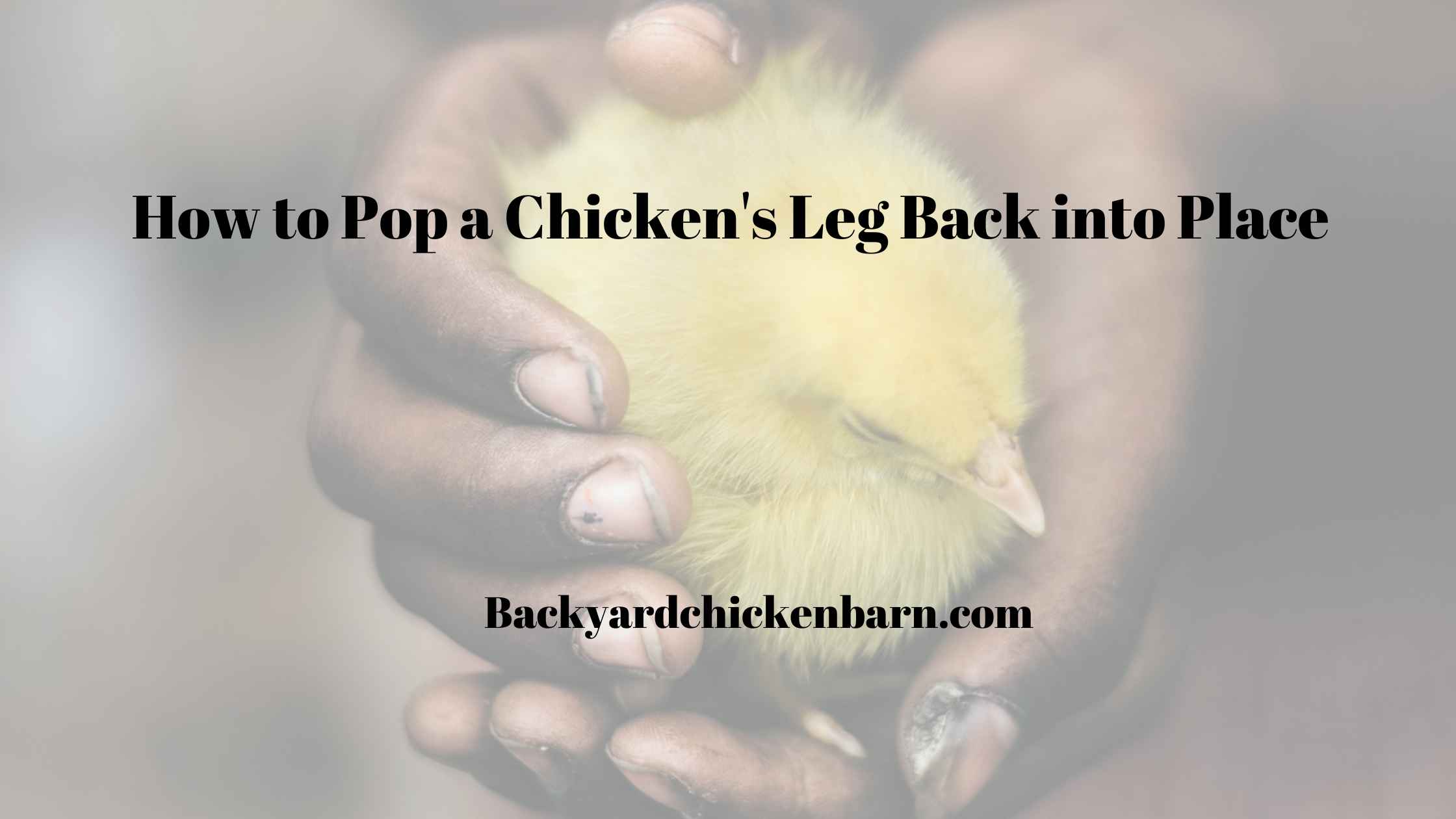How to Pop a Chicken’s Leg Back into Place
Disclaimer: Before attempting any of the following procedures, please note that dislocations or broken bones should ideally be addressed by a veterinarian or an experienced poultry keeper to avoid further injury.
If you’re not comfortable or experienced, it’s best to seek professional assistance.
1. Assessment
- Visual Inspection: Start by examining the chicken’s leg to determine if it’s a simple dislocation or a more severe break.
- Compare Both Legs: Compare the injured leg to the other to identify abnormalities.
- Check for Swelling and Heat: This can be indicative of an injury.
2. Prepare Your Workspace
- Choose a Calm Space: Ensure you’re in a calm, quiet area to keep stress to a minimum for both you and the chicken.
- Gather Supplies: You might need towels to restrain the bird gently, gloves, antiseptic (like betadine), and pain relief (consult a vet for the appropriate medicine and dosage).
3. Restraint
- Gentle Hold: Wrap the chicken in a towel, exposing only the injured leg. This not only keeps the bird still but can also have a calming effect.
4. Repositioning the Leg
- Feel the Joint: Before applying any pressure, feel the joint to understand its natural position.
- Gentle Pressure: Hold the thigh with one hand and the lower leg with the other. Gently move the leg until you feel the joint pop back into place. It should be a smooth movement, and you shouldn’t force it.
- Look and Feel: After you believe the leg is back in place, compare it again to the uninjured leg.
5. Post Care
- Rest: Even if the leg is back in place, the chicken will need time to recover. Ensure it’s separated from others in a comfortable, safe space.
- Monitor Swelling: If the leg swells or the chicken shows signs of pain, consult a veterinarian.
- Limit Movement: Consider confining the bird for a few days to prevent further injury. Monitor for signs of walking or standing difficulties.
- Pain Management: Consult with a vet regarding pain management solutions. Do not administer human medications without veterinary advice.
- Hydration and Food: Ensure the chicken continues to eat and drink. Offer food and water within easy reach.
6. Follow-up
- Monitor Recovery: Continue to watch your chicken’s progress over the next few weeks. Improvement should be noticeable, but if the condition worsens, seek veterinary care.
- Physical Therapy: Gently moving the leg can help regain strength and mobility. But again, be gentle and observe the chicken’s reactions.
Final Word:
While it’s possible to pop a chicken’s leg back into place, it’s essential to approach the situation with care and knowledge.
If at any point you’re unsure or if the chicken appears to be in distress, seek professional help immediately. Remember, a veterinarian will always be the best choice for addressing serious injuries.
ALSO SEE: Best Chicken Coop on Wheels

FAQs about Popping a Chicken’s Leg Back into Place
- Is it common for chickens to dislocate their legs?
- Answer: While not extremely common, injuries including dislocations can occur, especially if chickens have falls, fights, or mishaps with coop structures.
- Can I fix a dislocated chicken leg myself?
- Answer: While it’s possible to address minor dislocations with care, a veterinarian or experienced poultry keeper is recommended for severe injuries.
- How can I tell if my chicken’s leg is dislocated or broken?
- Answer: A dislocated leg may look out of position but won’t have the same level of deformity or irregular bone structures as a break.
- Is the procedure painful for the chicken?
- Answer: Realigning a dislocated joint can cause discomfort. It’s essential to be gentle and swift.
- How long does recovery take?
- Answer: Recovery varies but usually takes several weeks. It’s crucial to monitor the chicken during this period.
- Should I isolate the injured chicken from the flock?
- Answer: Yes, it helps reduce stress and prevents further injury from other birds.
- Are there signs I should watch out for after repositioning the leg?
- Answer: Monitor for increased swelling, limping, or if the chicken avoids putting weight on the leg.
- What if the leg pops out again?
- Answer: If the leg becomes dislocated again, it’s crucial to consult a veterinarian.
- Can I give my chicken pain medication?
- Answer: Always consult a veterinarian before giving any medication.
- How can I prevent such injuries in the future?
- Answer: Ensure the coop is free of hazards, and supervise interactions if introducing new birds.
- Is a dislocated leg a sign of an underlying health issue?
- Answer: Not typically. It’s often a result of an accident or mishap.
- Will my chicken be able to walk immediately after the procedure?
- Answer: It might take time, and the chicken might initially be hesitant or wobbly.
- How do I hold the chicken still during the procedure?
- Answer: Wrapping the chicken in a towel can help restrain and calm it.
- Can a chick experience a leg dislocation?
- Answer: Yes, chicks can also experience injuries, though they’re even more delicate.
- Should I be worried if the chicken doesn’t eat or drink after the procedure?
- Answer: Monitor closely. If the chicken avoids food or water for more than 24 hours, seek professional advice.
- Are certain breeds more prone to leg injuries?
- Answer: Larger breeds might be more susceptible due to their weight, but any chicken can suffer a dislocation.
- Can I use a splint on the chicken’s leg?
- Answer: Splints can be used for breaks but consult a veterinarian or expert for guidance.
- How can I tell if my chicken is in pain?
- Answer: Signs include lethargy, lack of appetite, and vocal distress signals.
- Are there natural remedies to aid recovery?
- Answer: While natural remedies might soothe, it’s essential to ensure they’re safe for chickens.
- Do roosters have a higher risk of leg injuries?
- Answer: Not necessarily, though they might have injuries from fights with other roosters.
- Is there a risk of infection after popping the leg back?
- Answer: Always ensure clean hands and a clean environment to reduce the risk.
- How do I clean the injured area?
- Answer: Use a mild antiseptic like betadine, but avoid harsh chemicals.
- Should I apply a cold or warm compress?
- Answer: Initially, a cold compress can reduce swelling, but consult a vet for prolonged care.
- Can a chicken fully recover from a dislocated leg?
- Answer: With proper care, many chickens can make a full recovery.
- How can I support my chicken during recovery?
- Answer: Offer easily accessible food and water, a comfortable resting place, and monitor regularly.
- Are older chickens more prone to injuries?
- Answer: Older chickens might be less agile, increasing their risk.
- Should I massage the injured leg?
- Answer: Gentle movement can help, but be very cautious not to cause further injury.
- What should I feed my chicken during recovery?
- Answer: Provide their regular diet but consider supplements after consulting a vet.
- Are there exercises to help with recovery?
- Answer: Gentle range-of-motion exercises can help, but should be approached with care.
- Can multiple injuries occur from a single incident?
- Answer: Yes, it’s possible for a chicken to suffer multiple injuries from one accident.
- How often should I check on the recovering chicken?
- Answer: Initially, check multiple times a day and then daily as the chicken improves.
- Should I reintroduce the recovered chicken to the flock slowly?
- Answer: Yes, gradual reintroduction helps reduce stress and potential aggression.
- Can humidity or temperature affect recovery?
- Answer: Ensure the chicken is in a comfortable environment, avoiding extreme temperatures.
- What if my chicken refuses to stand after recovery?
- Answer: This might indicate a deeper issue, and professional consultation is advised.
- Should I use bandages on the dislocated leg?
- Answer: Only if advised by a professional. Improper bandaging can cause more harm.
- How long should I keep the chicken isolated post-recovery?
- Answer: Until the chicken is confident and can move without visible pain or hesitation.
- Can the chicken develop arthritis after a dislocation?
- Answer: It’s possible, especially if the injury isn’t addressed promptly.
- Is surgery an option for severe dislocations?
- Answer: In some cases, surgery might be required. Consult a veterinarian.
- Can genetics play a role in a chicken’s susceptibility to dislocations?
- Answer: While genetics can influence overall health, accidents are the primary cause of dislocations.
- How can I make my coop safer to prevent future injuries?
- Answer: Regularly inspect for hazards, ensure stable perches, and provide ample space to reduce accidents.


